Follow the Ruts…
Pros and Cons – A Summary >>
Coal Loading Facility (or skip to Port facility):
There are two options for coal loading for a train, bring the train to the coal, or bring the coal to the train. The latter would have the least environmental and economic impact up front, but may represent a greater annoyance and impediment to other users in the future. Where as the former is more expensive but keeps mine activity much more contained.
Coal Conveyor from Mine to E&N: (see the companys response here)
Long conveyors are nothing new, including on Vancouver Island. There was a conveyor that went under Metchosin Rd. in Victoria for a long time until the gravel pit it served closed down.
More recently, a new gravel pit opened in Port McNeill with a conveyor that goes under Highway 19 on a 3km journey to the waters edge.
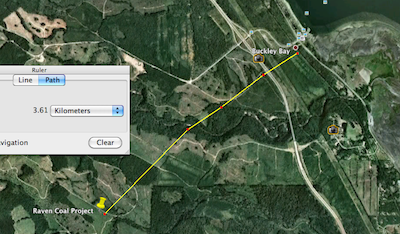
Here is a possible path on existing private timberlands.
A Conveyor from the Raven site to a point along the Island rail main line would represent the least possible impact, and could be easily removed once the mine is finished. The only infrastructure along the E&N would be the loading point itself and perhaps a small silo that could store a small amount of coal so that the conveyors could run when best suited to the company or neighbouring properties, rather than only when the train arrives. The disadvantage would be that the conveyor and the train loading point itself would be very close to existing residences and other mixed use areas.
CEO John Tapics Response: While a coal conveyor from the Raven Project to a point along the Island Rail mainline may be possible, the route you are suggesting would be challenging as it crosses the T’Sable River and the Inland Island Highway. —-November 16, 2010
A dedicated Raven Rail Spur (see the companys response here)
The Mine could also be served by it’s own rail line that branched off of the main E&N line somewhere south of Fanny Bay. Below is a possible route, taking into account terrain and using an existing pass through Highway 19.
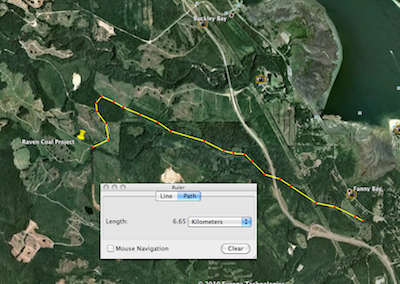
The area is criss crossed with historical rail beds that were used in the early 20th century for coal and forestry. The difficulty would be securing land for the rail spur and managing the number of river and stream crossings needed to get to the mine site. Crossing Highway 19 would also present a challenge.
Here is a view of it with the location of historical rail beds (blue dashed-line) and coal facilities. (click for larger image)
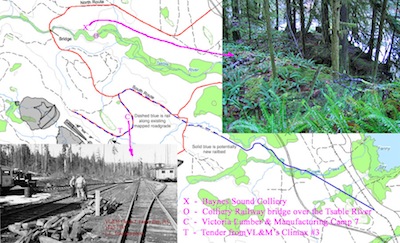
Having a dedicated rail spur would keep all mine activity close to the mine site, and as far away as possible from existing residences, businesses and other operations on the E&N, thus limiting overall impact over the life of the mine.
_______________________________
CEO John Tapics Response: The potential rail spur line to the Raven Project you have suggested has been investigated but it is not technically possible because the grade out of the Cowie Creek valley is too steep once you cross under the Inland Island Highway to meet the mainline at grade.—-November 16, 2010
Mr. Tapics provided the linked concept drawing done by Southern Rail of Vancouver Island showing how a Raven coal spur would fit with the existing Island Rail mainline. Their plan has the rail spur starting at mine 125.6 which is very near the Buckley Bay ferry terminal similar to my first conveyor drawing above.
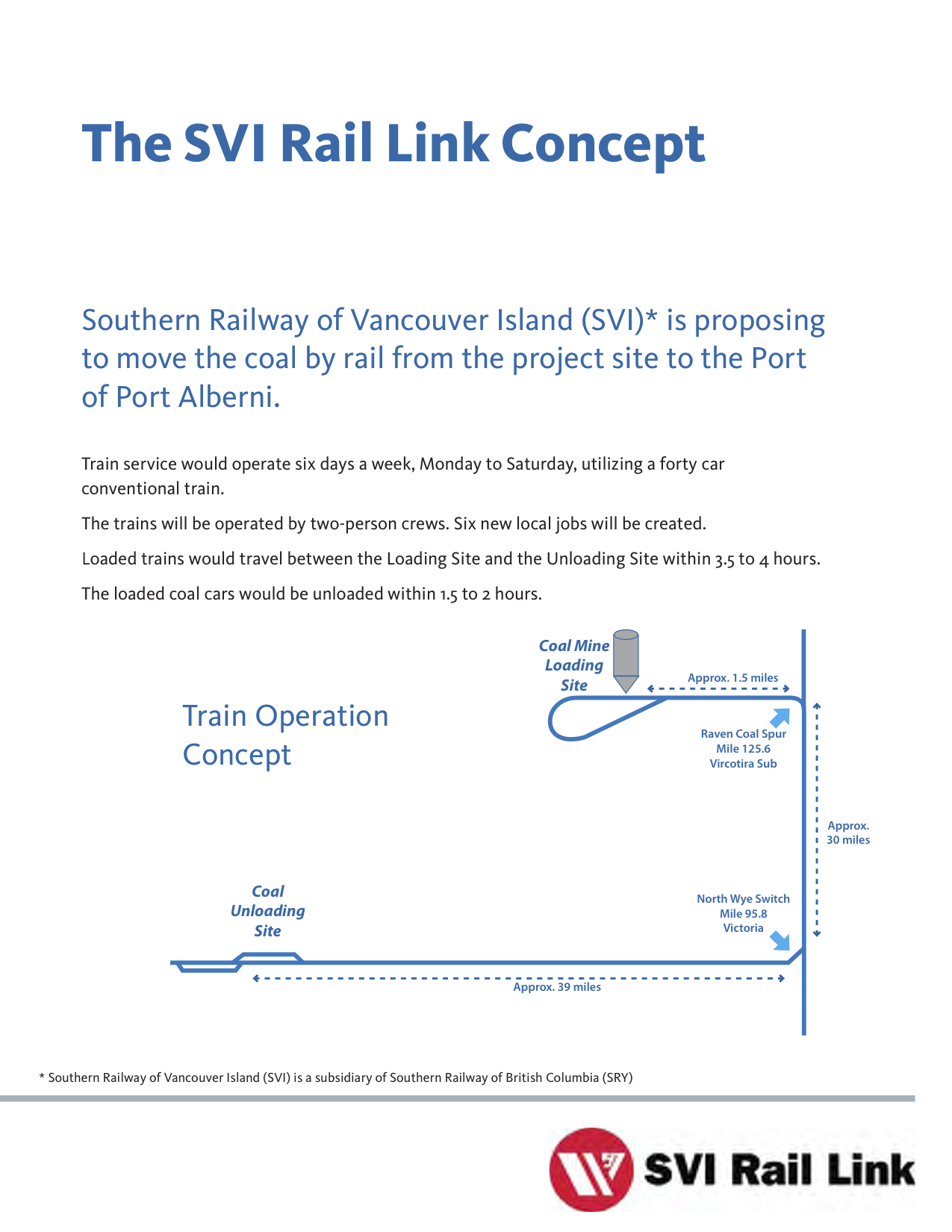
Coal Port Facility:
As with so many things with this project, the place they’ve chosen for the port facilities on Harbour Rd is in the worst possible location. It’s a stones throw from houses, Harbour Quay and Maritime Discovery center tourist and businesses ares, and if there is dust, it will end up right on top of Port Albernis “jewel” on the otherwise industrial waterfront.
What’s more, trucks, and trains, would cross directly in front of these tourist and residential areas producing major noise and air pollution for residents and businesses in the area and putting the safety of residents, and especially visitors, at risk.
Here is the design of the current facility.
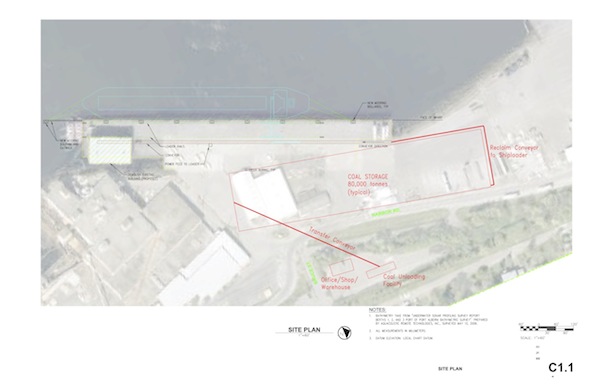
The Company has indicated, and the Federal and Provincial EA offices confirm that the Company would pay for all Port facilities, including the $50 Million facility currently envisioned for Harbour Rd with regular heavy industrial taxes being payed to the City.
Option A:(see the companys response here)
On WFP and Catalyst land in the railyard with conveyor around south side of Catalyst property.
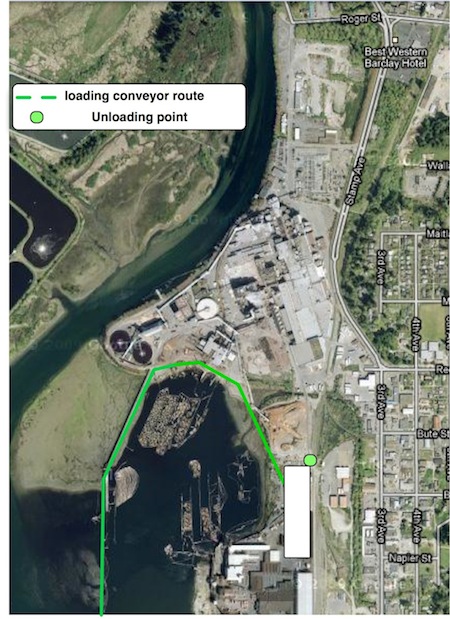
The existing rail yard could be reconfigured to include the unloading facility. The facility would be surrounded by industrial land and as far away as possible from residential and business areas. The ship loading conveyor would reach out into the Harbour, keeping ships, and coal dust, away from the shore.
Option B:(see the companys response here)
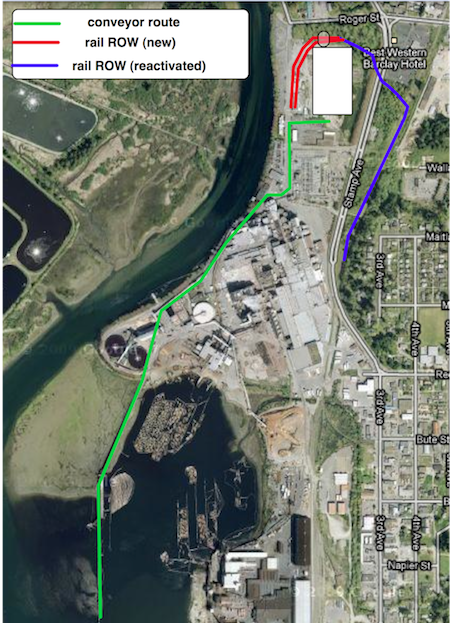
This would place the facility on land that is currently for sale by Catalyst Paper and is unused. The railway would use an old siding that existed in the 1980s, and used to cross Stamp Avenue near the Barclay Hotel. The right-of-way for the siding still exists near the Barcklay Hotel and along the main E&N line.
The two parallel red lines are where the new track splits into two parallel tracks. The railway has indicated they would do this to speed the unloading process (2 cars at a time) and cut down the length of land needed. The conveyor route would also put the ships in the middle of the Harbour away from the shore.
CEO John Tapics Response:
Coal Port Facility: Options A and B suggest the Raven Project load coal onto ships off of Lupsi Cupsi Point near the Catalyst Mill. This option is not workable as the water there is too shallow; at the end of the existing dock the water is only eight to eleven metres deep. More importantly, the loading facilities would need to go substantially further out into the harbour to reach the fourteen metre draft that is required by Panamax class vessels.—-November 16, 2010
_______________________________________________________________